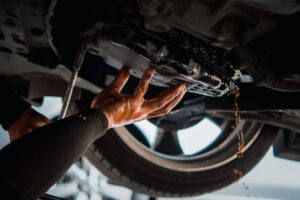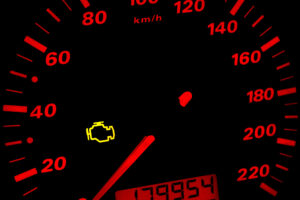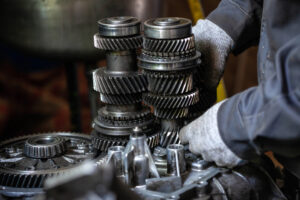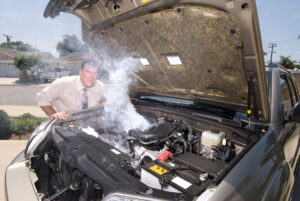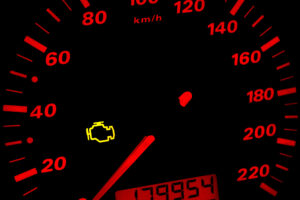When it comes to car problems, a Check Engine Light is tempting to ignore. If it’s steady, it typically indicates a persistent issue, which may not be serious—this is most common. However, if your Check Engine Light starts flashing, don’t procrastinate. This is one way that your car signals that there’s a more serious problem that requires professional attention—and soon. While dashboard warning lights are never a welcome sign, it’s important not to ignore them.
What Does a Flashing Check Engine Light Mean?
A Check Engine Light on your dashboard typically points to a problem related to fuel combustion or emissions. When it starts flashing, it’s a much more urgent sign—and it’s possible that extensive damage may be done to the engine or parts of the exhaust system, like the catalytic converter.
Misfires May Be Sending Fuel into the Exhaust System
One of the most common triggers for your Check Engine Light is misfires. This may be the underlying cause whether the warning light is steady or flashing—but if it’s flashing, it’s more likely that the misfires are more severe and unburned fuel may make it into the exhaust system. When handled right away, replacement of spark plugs, ignition coils, fuel injectors, or the timing belt can prevent more serious issues—but the longer it’s allowed to continue, the more you risk major engine and exhaust repairs.
Your Catalytic Converter May Be Failing
Whether from age and use or unburned fuel, a failing catalytic converter could be the cause of a flashing Check Engine Light. This component is responsible for taking harmful fumes as they leave the engine and converting them into more harmless compounds before they’re sent into the environment. Not only can a failing catalytic converter have environmental impacts, but it also reduces overall engine performance, leads to poor fuel economy, and can cause an unpleasant rotten egg smell—plus it has the potential to cause more extensive engine damage over time.
An Oxygen Sensor May Be Faulty
A bad oxygen sensor commonly triggers the Check Engine Light and can cause it to flash. This sensor monitors the oxygen content of exhaust fumes as they exit your vehicle. That data is then sent to the engine control module (ECM) so that the amount of fuel sent into the engine can be adjusted, if necessary, to create the right air-fuel ratio. A faulty oxygen sensor can cause too much or too little fuel to be sent into the engine, leading to bigger problems—and potentially a flashing Check Engine Light.
Next Steps if Your Check Engine Light is Flashing
Not only is your Check Engine Light on, but it’s flashing—what do you do next? By following a few key steps, you can help prevent further damage to your car’s engine. The less you need to drive, the better—and heading to a trusted mechanic as soon as possible will help get you safely back on the road again.
Find a Safe Place to Pull Over
As soon as you notice your Check Engine Light flashing, look for a safe place to pull to the side of the road and park. Turn on your flashers to help ensure you’re visible to other drivers. Even if you’re still able to drive your car, that doesn’t mean that it’s a good idea. The more you continue to drive, the higher your chances of causing more extensive damage to your engine or exhaust system.
If You Need to Continue Driving, Go Slowly
Sometimes, it’s necessary to continue driving—even if it’s not much further. In this case, take it easy. Don’t accelerate hard or go too fast. The more you push your engine, the higher your chances of bigger issues once you make it to an auto shop. Whenever possible, avoid driving and instead call for a tow truck—like your nearest AAMCO’s available towing service.
Pay Attention to Other Symptoms
Whether you continue to drive or not, pay close attention to any other symptoms or changes in performance from your vehicle. This could be strange sounds, new vibration, or reduced power while driving. When you get to a mechanic, explaining these symptoms can help point them in the right direction to start diagnostics and ensure the right repairs are done.
Trust a Professional with Diagnostics & Repairs
One of the most important steps to take if your car has a flashing Check Engine Light is to get it to a professional mechanic for diagnostics and repairs. While it’s possible that fixing the underlying issue can be straightforward, a trusted mechanic will help ensure all necessary repairs are handled so that you drive away with confidence—and and no surprises down the road.
Solve Your Dashboard Warning Light. Visit Your Local AAMCO.
Surprised by a flashing Check Engine Light? Don’t worry—the expert mechanics at your local AAMCO near Sacramento will help assess the situation, diagnose any underlying issues, and handle any necessary repairs to get you back on the road again. Schedule your appointment with us today!

